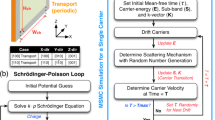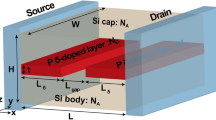Abstract
The impact of quantum mechanical space-quantization effects on the operation of a narrow-width SOI device structure has been investigated. The presence of a two-dimensional carrier confinement(both vertical and along the width direction) gives rise to larger average displacement of the carriers from the interface and lower sheet electron density in the channel region. This, in turn, results not only in a significant increase in the threshold voltage but also in pronounced channel width dependency of the drain current. In these simulations we have used classical 3D Monte Carlo particle-based simulations. Quantum mechanical space-quantization effects have been accounted for via an effective potential scheme that has been quite successful in describing bandgap widening effect and charge set back from the interface in conventional MOSFET devices.
Access this chapter
Tax calculation will be finalised at checkout
Purchases are for personal use only
Preview
Unable to display preview. Download preview PDF.
Similar content being viewed by others
References
Akis, R., Milicic, S., Ferry, D.K., Vasileska, D.: An effective potential method for including quantum effects into the simulation of ultra-short and ultra-narrow channel MOSFETs. In: Proceedings of the 4th International Conference on Modeling and Simulation of Microsystems, Hilton Head Island, SC, March 19-21, pp. 550–553 (2001)
Bohm, D.: A suggested interpretation of the quantum theory in terms of hidden variables. I. Phys. Rev. 85, 166 (1952)
Bohm, D.: A suggested interpretation of the quantum theory in terms of hidden variables. II. Phys. Rev. 85, 180 (1952)
de Broglie, L.: Sur la possibilité de relier les phénomènes d’interference et de diffraction á la théorie des quanta de luminère. C. R. Acad. Sci. Paris 183, 447 (1926)
de Broglie, L.: La structure atomique de la matière et du rayonnement et la Mécanique ondulatoire. C. R. Acad. Sci. Paris 184, 273 (1927)
Dewdney, C., Hiley, B.J.: A quantum potential description of one-dimensional time-dependent scattering from square barriers and square wells. Found. Phys. 12, 27 (1982)
Ferry, D.K., Akis, R., Vasileska, D.: Quantum Effects in MOSFETs: Use of an Effective Potential in 3D Monte Carlo Simulation of Ultra-Short Channel Devices, IEDM Tech. Dig, pp. 287–290. IEEE Press, New York (2000)
He, J., Xi, X., Chan, M., Cao, K., Hu, C., Li, Y., Zhang, X., Huang, R., Wang, Y.: Normalized mutual integral difference method to extract threshold voltage of MOSFETs. IEEE Electron Dev. Lett. 23, 428–430 (2002)
Herring, C., Vogt, E.: Transport and Deformation-Potential Theory for Many- Valley Semiconductors with Anisotropic Scattering. Phys. Rev. 101, 944 (1956)
Hockney, R.W., Eastwood, J.W.: Computer Simulation Using Particles. McGraw-Hill, Maidenhead (1981)
Laux, S.E.: On particle-mesh coupling in Monte Carlo semiconductor device simultion. IEEE Trans. CAD Integr. Circ. Syst. 15, 1266 (1996)
Madelung, E.: Quantatheorie in hydrodynamischer form. Z. Phys. 40, 322 (1926)
Majima, H., Ishikuro, H., Hiramoto, T.: Experimental evidence for quantum mechanical narrow channel effect in ultra-narrow MOSFET’s. IEEE Electron Dev. Lett. 21, 396 (2000)
Shahidi, G.G.: SOI Technology for the GHz era. IBM J. Res. & Dev. 46, 121 (2002)
Author information
Authors and Affiliations
Editor information
Editors and Affiliations
Rights and permissions
Copyright information
© 2004 Springer-Verlag Berlin Heidelberg
About this paper
Cite this paper
Ahmed, S.S., Vasileska, D. (2004). Modeling of Narrow-Width SOI Devices: The Role of Quantum Mechanical Narrow Channel Effects on Device Performance. In: Lirkov, I., Margenov, S., Waśniewski, J., Yalamov, P. (eds) Large-Scale Scientific Computing. LSSC 2003. Lecture Notes in Computer Science, vol 2907. Springer, Berlin, Heidelberg. https://doi.org/10.1007/978-3-540-24588-9_10
Download citation
DOI: https://doi.org/10.1007/978-3-540-24588-9_10
Publisher Name: Springer, Berlin, Heidelberg
Print ISBN: 978-3-540-21090-0
Online ISBN: 978-3-540-24588-9
eBook Packages: Springer Book Archive




